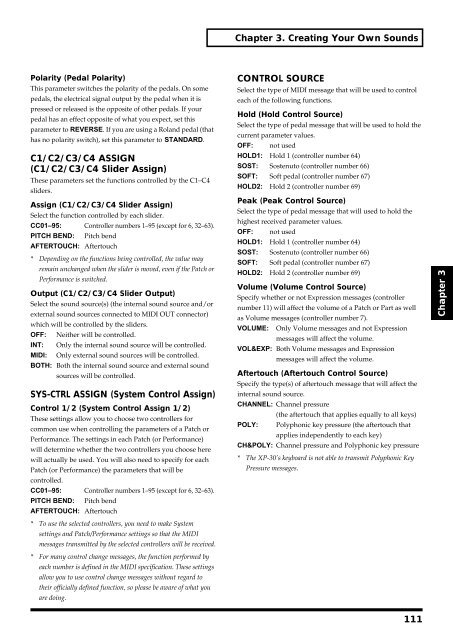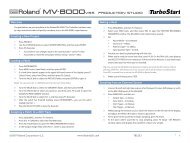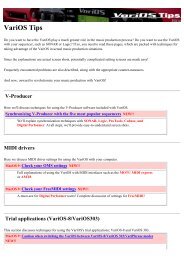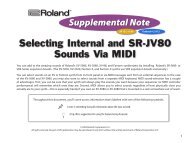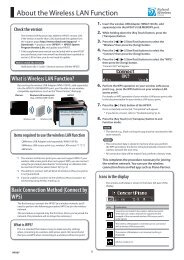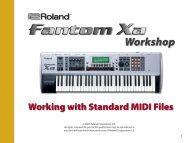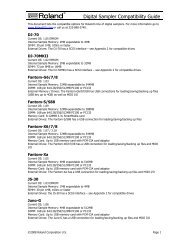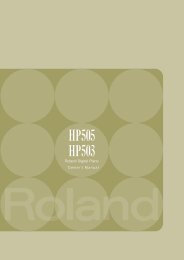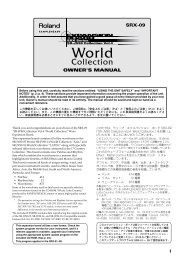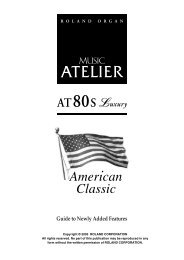You also want an ePaper? Increase the reach of your titles
YUMPU automatically turns print PDFs into web optimized ePapers that Google loves.
Chapter 3. Creating Your Own Sounds<br />
Polarity (Pedal Polarity)<br />
This parameter switches the polarity of the pedals. On some<br />
pedals, the electrical signal output by the pedal when it is<br />
pressed or released is the opposite of other pedals. If your<br />
pedal has an effect opposite of what you expect, set this<br />
parameter to REVERSE. If you are using a <strong>Roland</strong> pedal (that<br />
has no polarity switch), set this parameter to STANDARD.<br />
C1/C2/C3/C4 ASSIGN<br />
(C1/C2/C3/C4 Slider Assign)<br />
These parameters set the functions controlled by the C1–C4<br />
sliders.<br />
Assign (C1/C2/C3/C4 Slider Assign)<br />
Select the function controlled by each slider.<br />
CC01–95: Controller numbers 1–95 (except for 6, 32–63).<br />
PITCH BEND: Pitch bend<br />
AFTERTOUCH: Aftertouch<br />
* Depending on the functions being controlled, the value may<br />
remain unchanged when the slider is moved, even if the Patch or<br />
Performance is switched.<br />
Output (C1/C2/C3/C4 Slider Output)<br />
Select the sound source(s) (the internal sound source and/or<br />
external sound sources connected to MIDI OUT connector)<br />
which will be controlled by the sliders.<br />
OFF: Neither will be controlled.<br />
INT: Only the internal sound source will be controlled.<br />
MIDI: Only external sound sources will be controlled.<br />
BOTH: Both the internal sound source and external sound<br />
sources will be controlled.<br />
SYS-CTRL ASSIGN (System Control Assign)<br />
Control 1/2 (System Control Assign 1/2)<br />
These settings allow you to choose two controllers for<br />
common use when controlling the parameters of a Patch or<br />
Performance. The settings in each Patch (or Performance)<br />
will determine whether the two controllers you choose here<br />
will actually be used. You will also need to specify for each<br />
Patch (or Performance) the parameters that will be<br />
controlled.<br />
CC01–95: Controller numbers 1–95 (except for 6, 32–63).<br />
PITCH BEND: Pitch bend<br />
AFTERTOUCH: Aftertouch<br />
CONTROL SOURCE<br />
Select the type of MIDI message that will be used to control<br />
each of the following functions.<br />
Hold (Hold Control Source)<br />
Select the type of pedal message that will be used to hold the<br />
current parameter values.<br />
OFF: not used<br />
HOLD1: Hold 1 (controller number 64)<br />
SOST: Sostenuto (controller number 66)<br />
SOFT: Soft pedal (controller number 67)<br />
HOLD2: Hold 2 (controller number 69)<br />
Peak (Peak Control Source)<br />
Select the type of pedal message that will used to hold the<br />
highest received parameter values.<br />
OFF: not used<br />
HOLD1: Hold 1 (controller number 64)<br />
SOST: Sostenuto (controller number 66)<br />
SOFT: Soft pedal (controller number 67)<br />
HOLD2: Hold 2 (controller number 69)<br />
Volume (Volume Control Source)<br />
Specify whether or not Expression messages (controller<br />
number 11) will affect the volume of a Patch or Part as well<br />
as Volume messages (controller number 7).<br />
VOLUME: Only Volume messages and not Expression<br />
messages will affect the volume.<br />
VOL&EXP: Both Volume messages and Expression<br />
messages will affect the volume.<br />
Aftertouch (Aftertouch Control Source)<br />
Specify the type(s) of aftertouch message that will affect the<br />
internal sound source.<br />
CHANNEL: Channel pressure<br />
(the aftertouch that applies equally to all keys)<br />
POLY: Polyphonic key pressure (the aftertouch that<br />
applies independently to each key)<br />
CH&POLY: Channel pressure and Polyphonic key pressure<br />
* The XP-30’s keyboard is not able to transmit Polyphonic Key<br />
Pressure messages.<br />
Chapter 3<br />
* To use the selected controllers, you need to make System<br />
settings and Patch/Performance settings so that the MIDI<br />
messages transmitted by the selected controllers will be received.<br />
* For many control change messages, the function performed by<br />
each number is defined in the MIDI specification. These settings<br />
allow you to use control change messages without regard to<br />
their officially defined function, so please be aware of what you<br />
are doing.<br />
111


